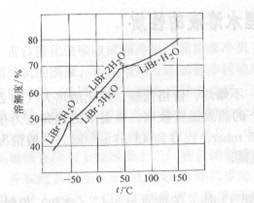Crystallization in LiBr Absorption Chillers and Its Impact on Unit Operation
In lithium bromide absorption chillers, the lithium bromide (LiBr) solution serves as the primary absorbent, enabling the refrigeration cycle through its strong ygroscopic properties. By readily absorbing water vapor, it maintains a low-temperature, low-pressure environment within the absorber, thereby facilitating chilled water production. However, LiBr solution exhibits temperature-dependent solubility characteristics. When operating parameters deviate from design specifications and the solution concentration exceeds its solubility limit at the prevailing temperature, LiBr precipitates from the liquid phase as solid crystals — a phenomenon referred to as crystallization.
The underlying mechanism can be illustrated by analogy to a supersaturated sugar solution: at elevated temperatures, more solute can be dissolved, whereas a reduction in temperature or an excessive solute concentration results in precipitation. In LiBr systems, similar thermodynamic principles apply, with crystallization occurring when supersaturation is reached.
Operational Implications of Crystallization
Crystallization presents significant operational risks for absorption chillers. Solid LiBr deposits can accumulate within circulation pathways, obstructing spray distributors and solution lines, thereby restricting absorbent flow. Furthermore, crystal deposition on heat exchanger surfaces forms an insulating layer, impairing heat transfer performance and substantially reducing cooling capacity. Flow restriction can also lead to localized thermal and pressure imbalances within the absorber or generator, compromising the stability of the absorption cycle.
If crystallization progresses unchecked, onboard monitoring and control systems will detect deviations in concentration, temperature, or pressure and initiate an automatic protective shutdown. This protective “forced outage” prevents mechanical damage but results in immediate loss of cooling capacity. Restoration requires controlled heating to dissolve the crystals, followed by mechanical inspection and removal of any residual blockages a process that is both time-consuming and operationally disruptive.
Primary Causes of Crystallization
- Typical initiating factors include:
- Excessively low cooling water temperatures, inducing localized absorber cooling.
- Elevated solution concentration beyond solubility thresholds.
- Interruption of heat input or solution circulation, causing rapid localized temperature drops.
- Improper startup or shutdown sequences, particularly abrupt cooling.
- Ingress of particulates or other impurities serving as nucleation sites.
Absorption Chiller Maintenance:To mitigate crystallization risk, strict operational control of LiBr concentration and temperature must be maintained. Continuous stability of the heat source and solution circulation should be ensured, and startup/shutdown procedures must adhere to manufacturer specifications. Additionally, maintaining high water quality standards minimizes the introduction of foreign particles that could promote nucleation. Adhering to these preventive practices enables long-term, reliable, and efficient operation of LiBr absorption chillers.

Post time: Aug-08-2025





